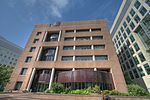Sean Collier Memorial
Abstract sculptures in the United StatesBoston Marathon bombingMassachusetts Institute of TechnologyMonuments and memorials in MassachusettsOutdoor sculptures in Cambridge, Massachusetts

The Sean Collier Memorial is a large abstract environmental sculpture located on the campus of the Massachusetts Institute of Technology in Cambridge, Massachusetts. It was designed by MIT faculty and students in memory of Sean Collier, a member of MIT Campus Police, who had been killed at the site by the Boston Marathon bombers on April 18, 2013. The project was proposed, designed, funded, fabricated, and installed in less than two years, and formally dedicated on April 29, 2015.
Excerpt from the Wikipedia article Sean Collier Memorial (License: CC BY-SA 3.0, Authors, Images).Sean Collier Memorial
North Court, Cambridge Cambridgeport
Geographical coordinates (GPS) Address External links Nearby Places Show on map
Geographical coordinates (GPS)
| Latitude | Longitude |
|---|---|
| N 42.36227 ° | E -71.09007 ° |
Address
Sean Collier Memorial
North Court
02238 Cambridge, Cambridgeport
Massachusetts, United States
Open on Google Maps








